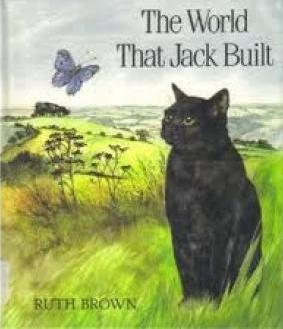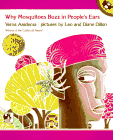The World that Jack Built

by Ruth Brown. ![]() Picture Book. 32 pages. Grades PreK-3.
Picture Book. 32 pages. Grades PreK-3.
Find this book: Amazon

Teacher's Guide

The front endpapers show us a lovely butterfly against a blue sky and that butterfly is going to lead us and the principal character, a black cat, from a beautiful, sparkling landscape to the destructive pollution put out by a factory.
The title page has the cat already in pursuit and the opening spread is of a beautiful, faintly English country scene complete with country manor, stone walls and abundant flowers, one of which bears the butterfly. In "This Is the House That Jack Built" style, we and the cat are led by our flittering guide to the trees growing by the house, to the stream that flows past them, across the meadows, through the woods, to the hills that form the valley where we see the first ominous note of polluted air in the distance. The next page leads us to the adjoining valley where the pollution is heavier and the vegetation less colorful, through more woods where everything is dead or dying, and the air is smoggy enough to inhibit visibility, to a contaminated meadow, a chemical-laden stream to the factory that Jack built, the cause of all the horror we've seen. The final endpapers show us both cat and butterfly rushing homeward.
(Continued Below)
Advertisement:

Things to Talk About and Notice
- It takes careful looking to see what's going on here, so give the children ample chance to do so, keeping the viewing group small and suggesting that they look carefully at the pictures later for further details. One adult student, for instance, missed the whole point and thought it was a lyrical book encouraging life in the country.
- The fact that Jack built both the house and the factory is another point that may be missed by the casual observer. Such questions as "Could Jack have afforded the house if he didn't have the factory?" "Which valley has he chosen to live in?" "Could he have built a factory that doesn't pollute?"
- Someone may notice that the sequence reverses itself in this story. The factory compares to the house as end-pins of the story. Could we have started with the factory and worked back to the house?
- The cat and the butterfly can't leave that polluted place soon enough. How much space exists between you and pollution? Is that changing?

Activities
- You may be able to figure out what kind of a butterfly that is, but even if you can't, you can find out that a monarch butterfly, for instance, will only lay her eggs on a milkweed leaf, for it's the only thing the caterpillar of that species will eat. Does the pollution threaten this butterfly's life?
- Children might like to rewrite other Mother Goose poems or songs with a pollution theme in mind: "The Green Grass Grows All Around," and "Hole In the Bottom of the Sea, " come to mind for instance.
- This book concerns a world built by Jack. There are other worlds with which children are familiar to which this one can be compared: worlds constructed by Disney, Donald Trump, Mr. Rogers, Fraggle Rock and even the world of Christopher Robin. What are the rules and the problems within those worlds? What about Sesame Street?
- It's particularly important, especially if you're using this book in the lower grades, that children not be left feeling powerless and depressed about pollution, so spend some time showing them some of the things they can do to help: recycling, being careful about overuse of disposables, fixing things instead of junking them and the like. A survey of the school's trash may lead them to specific things they can do? Is the school using biodegradable and recycled materials as much as possible? Children need to be aware, not despondent and The World That Jack Built can offer both awareness and possible solutions.
(Continued Below)
Advertisement:

Related Books
 Comparisons abound, of course, between this and other cumulative stories and you may lighten the lesson a bit by getting into some like The Jacket I Wear in the Snow by Shirley Neitzel (Greenwillow, 1989 ISBN 0-688-08030-8) and Why Mosquitoes Buzz in People's Ears by Verna Aardema (Dial, 1978 ISBN 0-8037-6088-4.)
Comparisons abound, of course, between this and other cumulative stories and you may lighten the lesson a bit by getting into some like The Jacket I Wear in the Snow by Shirley Neitzel (Greenwillow, 1989 ISBN 0-688-08030-8) and Why Mosquitoes Buzz in People's Ears by Verna Aardema (Dial, 1978 ISBN 0-8037-6088-4.)
-
Zip back to The World That Jack Built with questions like: "Would you have a jacket if it weren't for factories?" "Can the mosquito and other animals in that story be affected by pollution?"
Children who have read Ruth Brown's A Dark Dark Tale (Dial, 1981 ISBN 0-8037-0093-8) may recognize the cat as, if not the same one, a very similar one. Could the cat be Jack?
- You might want to look at some other picture books which deal with pollution and ecology such as Virginia Burton's Little House (Houghton, 1978 ISBN 0-395-18156-9,) Bill Peet's The Wump World (Houghton, 1974 ISBN 0-395-19841-0,) Chris Van Allsburg's Just a Dream (Houghton, 1991,) and Dr. Seuss's The Lorax (Random, 1971 ISBN 0-394-82337-0.)
(Continued Below)
Advertisement:

Related Areas Within Carol Hurst's Children's Literature Web Site
- Free Teacher's Guides: A listing of all our teacher's guides. Picture Books, Nonfiction and Fiction.

